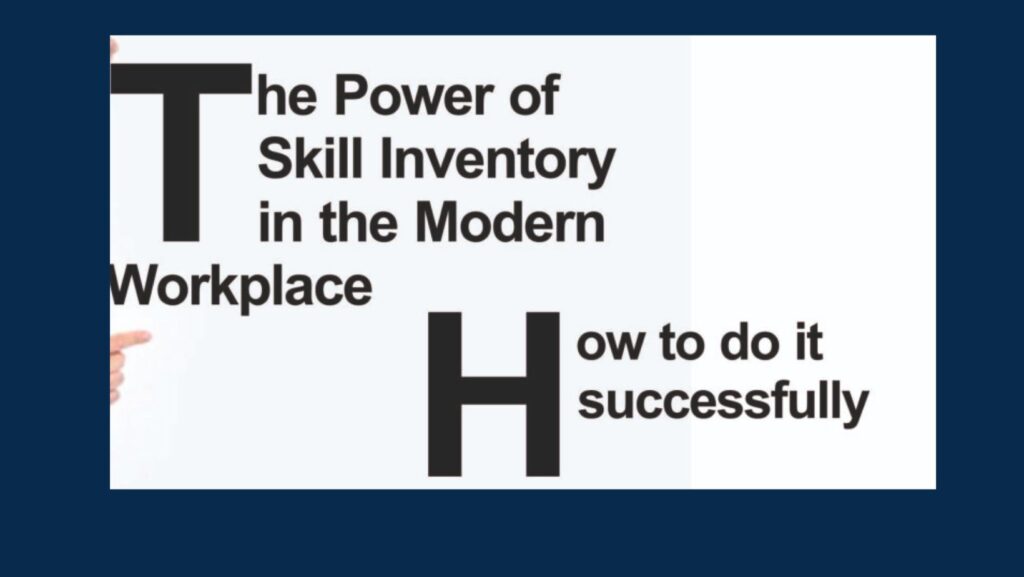Introduction: Skill Inventory
In today’s rapidly evolving business landscape, organizations face numerous challenges in staying competitive and meeting the ever-changing demands of their customers. One critical factor that plays a pivotal role in the success of modern organizations is the skill set possessed by their workforce. A comprehensive understanding of the skills and competencies present within the organization is essential for effective workforce planning, talent management, and overall organizational development. This is where a Skill Inventory comes into play. A Skill Inventory is a systematic and organized record of the skills, knowledge, and expertise that employees bring to the table. It provides valuable insights into the capabilities of the workforce, allowing organizations to make informed decisions regarding talent acquisition, training and development, project staffing, and succession planning. In this article, we will explore the reasons why a Skill Inventory is indispensable for any modern organization and how it serves as a foundation for strategic decision-making and sustainable growth. By harnessing the power of a Skill Inventory, organizations can optimize their workforce, maximize employee potential, and navigate the complexities of today’s business environment with confidence.

Skill Inventory is essential in any modern organization for several reasons:
- Workforce planning: A skill inventory helps organizations identify the skills and competencies present within their workforce. It provides a comprehensive overview of the skills employees possess, allowing organizations to strategically plan for future talent needs. By understanding the current skill sets, organizations can identify any gaps and take proactive measures to fill them, either through hiring, training, or reassigning tasks.
- Talent management: A skill inventory enables effective talent management by providing insights into the skills and capabilities of employees. It helps in identifying high-potential individuals, determining areas for development, and creating personalized career paths. By leveraging the skill inventory, organizations can align their employees’ skills with the company’s goals, resulting in improved employee satisfaction, engagement, and retention.
- Succession planning: Organizations need to be prepared for potential leadership transitions or employee departures. A skill inventory allows organizations to identify employees who possess critical skills or knowledge that may be required in the future. This information enables effective succession planning by identifying suitable candidates for key roles and facilitating the transfer of knowledge and skills from experienced employees to new hires or successors.
- Project staffing: Skill inventories provide valuable information for project managers when assembling project teams. By understanding the skills and expertise available within the organization, project managers can select team members who possess the necessary skills to successfully execute the project. This increases the likelihood of project success, enhances collaboration, and optimizes resource allocation.
- Training and development: A skill inventory helps identify skill gaps and areas where employees may benefit from additional training and development. Organizations can use this information to design targeted training programs that address specific skill deficiencies. By investing in employee development, organizations foster a learning culture and enhance the overall skill level of their workforce, leading to improved performance and adaptability.
- Restructuring and reorganization: During periods of organizational change, such as mergers, acquisitions, or restructuring, a skill inventory becomes even more crucial. It provides valuable insights into the skills present within different departments or teams, facilitating the process of aligning resources, identifying redundancies, and determining skill transferability. This information supports informed decision-making and minimizes disruption during times of transition.
How to conduct Skill Inventory

Creating an effective skills inventory for your organization is a crucial task that requires careful planning and design. To ensure the success of your inventory, consider following these eight steps:
- Determine the purpose of the inventory Before embarking on the creation of your skills inventory, it is essential to define how you intend to use it. Will it be used for employee training programs, company growth initiatives, or developing a hiring strategy? Clearly establishing the purpose will guide the subsequent steps.
- Decide which skills to include Once the goal of the skills inventory is established, you need to determine which skills to include. Consider a combination of soft skills, such as communication and collaboration abilities, as well as technical skills like programming proficiency. It is also beneficial to include essential skills like leadership and situational judgment.
- Evaluate employees’ skill levels Conduct a thorough assessment of your employees’ skills to gain insights into their capabilities. This evaluation can be done through pre-employment skills testing or one-on-one sessions to gather information about their strengths and areas for improvement.
- Document the findings Create a comprehensive record of your employees and the skills they possess. There are various methods to document this information, such as using tables or bulleted lists. Whichever approach you choose, ensure that the information is organized, structured logically, and accurate.
- Develop a skills matrix for an overview A skills matrix provides a visual representation of the data on employees’ skills. It allows for a quick overview of each employee’s skill set. Utilize bar charts, graphs, spreadsheets, or tables to depict the proficiency levels of individual employees. This visual representation facilitates faster decision-making by eliminating the need to sift through scattered information.
- Identify areas for improvement Review your skills inventory to identify areas that require improvement. This analysis can reveal skill gaps within the workforce or highlight the need for new talent in specific areas. Identifying these areas for growth will help you seize opportunities for improvement.
- Establish an updatable document To ensure the ongoing effectiveness of your skills inventory, make it an editable document that can be regularly updated. This allows for the inclusion of new information and adjustments as the workforce evolves. Share the document with relevant stakeholders, such as the board of directors, for review and analysis.
- Share the inventory with the core disciplinary team The final step involves sharing the skills inventory with your core disciplinary team. This collaborative approach enables better decision-making regarding your workforce and the overall company strategy.
In addition to above, If you are considering conducting a skills inventory in your organization, there are a few things you should keep in mind:
- Start with a clear purpose. What do you hope to achieve by conducting a skills inventory? Once you know your purpose, you can tailor the process to meet your specific needs.
- Get buy-in from employees. Employees are more likely to participate in a skills inventory if they understand the purpose and benefits. Make sure to communicate with employees about the process and why it is important.
- Use a variety of methods. There is no one-size-fits-all approach to conducting a skills inventory. Use a variety of methods to gather data, such as self-assessments, interviews, and performance reviews.
- Keep the process simple. The skills inventory process should be easy to understand and participate in. The simpler the process, the more likely employees are to complete it.
A skills inventory can be a valuable tool for organizations of all sizes. By taking the time to conduct a skills inventory, you can improve your workforce planning, increase employee engagement, and reduce costs.
Conclusion
A skill inventory is necessary in modern organizations to drive strategic workforce planning, enable effective talent management, support succession planning, optimize project staffing, facilitate training and development initiatives, and aid in organizational restructuring. It empowers organizations to leverage their employees’ skills effectively, adapt to changing business needs, and achieve long-term success.
FAQ
Q: What is a skill inventory?
A: A skill inventory is a systematic record or database that captures and catalogues the skills, knowledge, and expertise of employees within an organization. It provides a comprehensive overview of the skills present in the workforce.
Q: Why is a skill inventory important for organizations?
A: A skill inventory is crucial for organizations because it allows them to identify the skills and competencies available within their workforce. This information enables effective talent management, workforce planning, project staffing, succession planning, and training and development initiatives.
Q: How is a skill inventory created?
A: A skill inventory is typically created through a structured process that involves gathering information about employees’ skills. This can be done through surveys, self-assessments, performance evaluations, or interviews. The collected data is then compiled and organized into a centralized system or database.
Q: What are the benefits of maintaining a skill inventory? A: Maintaining a skill inventory offers several benefits. It helps organizations make informed decisions regarding talent acquisition, employee development, and project assignments. It supports succession planning by identifying suitable candidates for key roles. Additionally, it enables organizations to adapt to changing business needs, optimize resource allocation, and foster a learning culture.
Q: How can a skill inventory support talent management? A: A skill inventory provides insights into employees’ skills and capabilities, allowing organizations to effectively manage talent. It helps identify high-potential individuals, create personalized career paths, and align employees’ skills with organizational goals. This enhances employee satisfaction, engagement, and retention.
Q: Can a skill inventory be used for project staffing?
A: Yes, a skill inventory is valuable for project staffing. It allows project managers to identify individuals with the necessary skills and expertise required for specific projects. By leveraging the skill inventory, project managers can assemble teams with the right skill sets, leading to improved project outcomes.
Q: How does a skill inventory support organizational restructuring?
A: During periods of organizational restructuring, a skill inventory plays a crucial role. It helps identify the skills present within different departments or teams, facilitating resource reallocation, identifying redundancies, and determining skill transferability. This information supports informed decision-making and minimizes disruption during times of transition.
Q: Is a skill inventory a one-time process?
A: No, a skill inventory is an ongoing process. Skills evolve over time, new skills emerge, and employees acquire additional competencies. Regularly updating the skill inventory ensures that organizations have accurate and up-to-date information to support their talent management and decision-making processes.
Q: How can technology assist in maintaining a skill inventory?
A: Technology plays a significant role in maintaining a skill inventory. HR information systems, talent management software, or dedicated skill inventory platforms can be used to capture, organize, and update skill-related data. These tools provide efficient ways to manage and analyze the information, enhancing the effectiveness of the skill inventory process.
Q: Is a skill inventory only applicable to large organizations?
A: No, skill inventories are valuable for organizations of all sizes. Whether large or small, understanding the skills and capabilities of the workforce is crucial for effective talent management, project execution, and strategic decision-making. Skill inventories can be tailored to suit the specific needs and resources of each organization.
Remember, a skill inventory is a dynamic tool that empowers organizations to leverage their employees’ skills effectively, adapt to changing circumstances, and drive sustainable growth.

